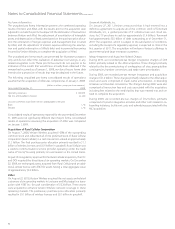Verizon Wireless 2010 Annual Report Download - page 48
Download and view the complete annual report
Please find page 48 of the 2010 Verizon Wireless annual report below. You can navigate through the pages in the report by either clicking on the pages listed below, or by using the keyword search tool below to find specific information within the annual report.
46
Notes to Consolidated Financial Statements
NOTE 1
DESCRIPTION OF BUSINESS AND SUMMARY OF SIGNIFICANT ACCOUNTING POLICIES
Basis of Presentation
We have reclassified certain prior year amounts to conform to the current
year presentation. Also, refer to “Employee Benefit Plans” below regarding
a change in accounting for benefit plans.
Corporate, eliminations and other during the periods presented include a
non-cash adjustment of $0.2 billion, ($0.1 billion) and ($34 million) in 2010,
2009 and 2008, respectively, primarily to adjust wireless data revenues. This
adjustment was recorded to properly defer previously recognized wireless
data revenues that will be earned and recognized in future periods. The
adjustment was recorded during 2010, which reduced Net income (loss)
attributable to Verizon by approximately $0.1 billion. Consolidated rev-
enues in 2009 and 2008 were not affected as the amounts involved were
not material to our consolidated financial statements.
Use of Estimates
We prepare our financial statements using U.S. generally accepted
accounting principles (GAAP), which require management to make esti-
mates and assumptions that affect reported amounts and disclosures.
Actual results could differ from those estimates.
Examples of significant estimates include: the allowance for doubtful
accounts, the recoverability of plant, property and equipment, the recov-
erability of intangible assets and other long-lived assets, unbilled revenues,
fair values of financial instruments, unrecognized tax benefits, valuation
allowances on tax assets, accrued expenses, pension and postretirement
benefit assumptions, contingencies and allocation of purchase prices in
connection with business combinations.
Revenue Recognition
Domestic Wireless
Our Domestic Wireless segment earns revenue by providing access to
and usage of its network, which includes voice and data revenue. In
general, access revenue is billed one month in advance and recognized
when earned. Usage revenue is generally billed in arrears and recognized
when service is rendered. Equipment sales revenue associated with the
sale of wireless handsets and accessories is recognized when the prod-
ucts are delivered to and accepted by the customer, as this is considered
to be a separate earnings process from the sale of wireless services. For
agreements involving the resale of third-party services in which we are
considered the primary obligor in the arrangements, we record the rev-
enue gross at the time of the sale.
Wireline
Our Wireline segment earns revenue based upon usage of its network
and facilities and contract fees. In general, fixed monthly fees for voice,
video, data and certain other services are billed one month in advance
and recognized when earned. Revenue from services that are not fixed in
amount and are based on usage is generally billed in arrears and recog-
nized when such services are provided.
When we bundle the equipment with maintenance and monitoring ser-
vices, we recognize equipment revenue when the equipment is installed
in accordance with contractual specifications and ready for the cus-
tomer’s use. The maintenance and monitoring services are recognized
monthly over the term of the contract as we provide the services. Long-
term contracts are accounted for using the percentage of completion
method. We use the completed contract method if we cannot estimate
the costs with a reasonable degree of reliability.
VERIZON COMMUNICATIONS INC. AND SUBSIDIARIES
Description of Business
Verizon Communications Inc. (Verizon or the Company) is one of the
world’s leading providers of communications services. We have two
reportable segments, Domestic Wireless and Wireline. For further infor-
mation concerning our business segments, see Note 14.
Verizon’s Domestic Wireless segment, operating as Verizon Wireless, pro-
vides wireless voice and data services and equipment across the United
States (U.S.) using one of the most extensive and reliable wireless net-
works in the nation. Verizon Wireless continues to expand its penetration
of data services and offerings of data devices for both consumer and
business customers.
Our Wireline segment provides communications services, including voice,
broadband video and data, network access, nationwide long distance
and other communications products and services, and also owns and
operates one of the most expansive end-to-end global Internet Protocol
(IP) networks. We continue to deploy advanced broadband network
technology, with our fiber-to-the-premises network, operated under the
FiOS service mark, creating a platform with sufficient bandwidth and
capabilities to meet customers’ current and future needs. FiOS allows
us to offer our customers a wide array of broadband services, including
advanced data and video offerings. Our IP network includes over 485,000
route miles of fiber optic cable and provides access to over 150 countries
across six continents, enabling us to provide next-generation IP network
products and information technology services to medium and large busi-
nesses and government customers worldwide.
Consolidation
The method of accounting applied to investments, whether consoli-
dated, equity or cost, involves an evaluation of all significant terms of
the investments that explicitly grant or suggest evidence of control or
influence over the operations of the investee. The consolidated financial
statements include our controlled subsidiaries. For controlled subsidiaries
that are not wholly owned, the noncontrolling interest is included in Net
income and Total equity. Investments in businesses which we do not
control, but have the ability to exercise significant influence over oper-
ating and financial policies, are accounted for using the equity method.
Investments in which we do not have the ability to exercise significant
influence over operating and financial policies are accounted for under
the cost method. Equity and cost method investments are included in
Investments in unconsolidated businesses in our consolidated balance
sheets. Certain of our cost method investments are classified as available-
for-sale securities and adjusted to fair value pursuant to the accounting
standard related to debt and equity securities. All significant intercom-
pany accounts and transactions have been eliminated.
























